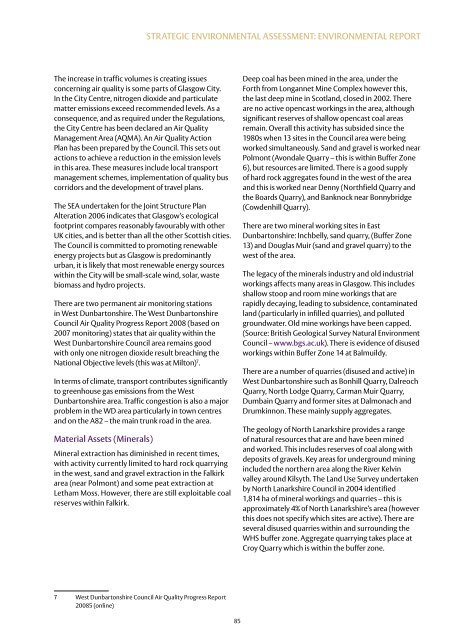The Antonine Wall Management Plan 2013-18 - Glasgow City Council
The Antonine Wall Management Plan 2013-18 - Glasgow City Council
The Antonine Wall Management Plan 2013-18 - Glasgow City Council
You also want an ePaper? Increase the reach of your titles
YUMPU automatically turns print PDFs into web optimized ePapers that Google loves.
Strategic Environmental Assessment: Environmental Report<br />
<strong>The</strong> increase in traffic volumes is creating issues<br />
concerning air quality is some parts of <strong>Glasgow</strong> <strong>City</strong>.<br />
In the <strong>City</strong> Centre, nitrogen dioxide and particulate<br />
matter emissions exceed recommended levels. As a<br />
consequence, and as required under the Regulations,<br />
the <strong>City</strong> Centre has been declared an Air Quality<br />
<strong>Management</strong> Area (AQMA). An Air Quality Action<br />
<strong>Plan</strong> has been prepared by the <strong>Council</strong>. This sets out<br />
actions to achieve a reduction in the emission levels<br />
in this area. <strong>The</strong>se measures include local transport<br />
management schemes, implementation of quality bus<br />
corridors and the development of travel plans.<br />
<strong>The</strong> SEA undertaken for the Joint Structure <strong>Plan</strong><br />
Alteration 2006 indicates that <strong>Glasgow</strong>’s ecological<br />
footprint compares reasonably favourably with other<br />
UK cities, and is better than all the other Scottish cities.<br />
<strong>The</strong> <strong>Council</strong> is committed to promoting renewable<br />
energy projects but as <strong>Glasgow</strong> is predominantly<br />
urban, it is likely that most renewable energy sources<br />
within the <strong>City</strong> will be small-scale wind, solar, waste<br />
biomass and hydro projects.<br />
<strong>The</strong>re are two permanent air monitoring stations<br />
in West Dunbartonshire. <strong>The</strong> West Dunbartonshire<br />
<strong>Council</strong> Air Quality Progress Report 2008 (based on<br />
2007 monitoring) states that air quality within the<br />
West Dunbartonshire <strong>Council</strong> area remains good<br />
with only one nitrogen dioxide result breaching the<br />
National Objective levels (this was at Milton) 7 .<br />
In terms of climate, transport contributes significantly<br />
to greenhouse gas emissions from the West<br />
Dunbartonshire area. Traffic congestion is also a major<br />
problem in the WD area particularly in town centres<br />
and on the A82 – the main trunk road in the area.<br />
Material Assets (Minerals)<br />
Mineral extraction has diminished in recent times,<br />
with activity currently limited to hard rock quarrying<br />
in the west, sand and gravel extraction in the Falkirk<br />
area (near Polmont) and some peat extraction at<br />
Letham Moss. However, there are still exploitable coal<br />
reserves within Falkirk.<br />
Deep coal has been mined in the area, under the<br />
Forth from Longannet Mine Complex however this,<br />
the last deep mine in Scotland, closed in 2002. <strong>The</strong>re<br />
are no active opencast workings in the area, although<br />
significant reserves of shallow opencast coal areas<br />
remain. Overall this activity has subsided since the<br />
1980s when 13 sites in the <strong>Council</strong> area were being<br />
worked simultaneously. Sand and gravel is worked near<br />
Polmont (Avondale Quarry – this is within Buffer Zone<br />
6), but resources are limited. <strong>The</strong>re is a good supply<br />
of hard rock aggregates found in the west of the area<br />
and this is worked near Denny (Northfield Quarry and<br />
the Boards Quarry), and Banknock near Bonnybridge<br />
(Cowdenhill Quarry).<br />
<strong>The</strong>re are two mineral working sites in East<br />
Dunbartonshire: Inchbelly, sand quarry, (Buffer Zone<br />
13) and Douglas Muir (sand and gravel quarry) to the<br />
west of the area.<br />
<strong>The</strong> legacy of the minerals industry and old industrial<br />
workings affects many areas in <strong>Glasgow</strong>. This includes<br />
shallow stoop and room mine workings that are<br />
rapidly decaying, leading to subsidence, contaminated<br />
land (particularly in infilled quarries), and polluted<br />
groundwater. Old mine workings have been capped.<br />
(Source: British Geological Survey Natural Environment<br />
<strong>Council</strong> – www.bgs.ac.uk). <strong>The</strong>re is evidence of disused<br />
workings within Buffer Zone 14 at Balmuildy.<br />
<strong>The</strong>re are a number of quarries (disused and active) in<br />
West Dunbartonshire such as Bonhill Quarry, Dalreoch<br />
Quarry, North Lodge Quarry, Carman Muir Quarry,<br />
Dumbain Quarry and former sites at Dalmonach and<br />
Drumkinnon. <strong>The</strong>se mainly supply aggregates.<br />
<strong>The</strong> geology of North Lanarkshire provides a range<br />
of natural resources that are and have been mined<br />
and worked. This includes reserves of coal along with<br />
deposits of gravels. Key areas for underground mining<br />
included the northern area along the River Kelvin<br />
valley around Kilsyth. <strong>The</strong> Land Use Survey undertaken<br />
by North Lanarkshire <strong>Council</strong> in 2004 identified<br />
1,814 ha of mineral workings and quarries – this is<br />
approximately 4% of North Lanarkshire’s area (however<br />
this does not specify which sites are active). <strong>The</strong>re are<br />
several disused quarries within and surrounding the<br />
WHS buffer zone. Aggregate quarrying takes place at<br />
Croy Quarry which is within the buffer zone.<br />
7 West Dunbartonshire <strong>Council</strong> Air Quality Progress Report<br />
20085 (online)<br />
85











![Elgin Cathedral Wedding Brochure [pdf, 544kb] - Historic Scotland](https://img.yumpu.com/22301571/1/190x151/elgin-cathedral-wedding-brochure-pdf-544kb-historic-scotland.jpg?quality=85)




